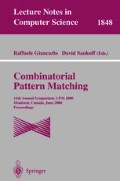Abstract
The Maximum Isomorphic Agreement Subtree (MIT) problem is one of the simplest versions of the Maximum Interval Weight Agreement Subtree method (MIWT) which is used to compare phylogenies. More precisely MIT allows to provide a subset of the species such that the exact distances between species in such subset is preserved among all evolutionary trees considered. In this paper, the approximation complexity of the MIT problem is investigated, showing that it cannot be approximated in polynomial time within factor logδ n for any δ > 0 unless NP ⊂ DTIME(2polylog n) for instances containing three trees. Moreover, we show that such result can be strengthened whenever instances of the MIT problem can contain an arbitrary number of trees, since MIT shares the same approximation lower bound of MAX CLIQUE.
Access this chapter
Tax calculation will be finalised at checkout
Purchases are for personal use only
Preview
Unable to display preview. Download preview PDF.
References
A. Amir and D. Keselman. Maximum agreement subtree in a set of evolutionary trees: Metrics and efficient algorithms. SIAM Journal on Computing, 26(6):1656–1669, 1997.
R. Cole, M. Farach, R. Hariharan, T. Przytycka, and M. Thorup. An O(n log n) algorithm for the maximum agreement subtree problem for binary trees. SIAM Journal on Computing, to appear.
R. Cole and R. Hariharan. An O(n log n) algorithm for the maximum agreement subtree problem for binary trees. In Proc. of the 7th Annual ACM-SIAM Symposium on Discrete Algorithms (SODA96), pages 323–332, 1996.
M. Farach, T. M. Przytycka, and M. Thorup. On the agreement of many trees. Information Processing Letters, 55(6):297–301, 1995.
M. Farach and M. Thorup. Fast comparison of evolutionary trees. Information and Computation, 123(1):29–37, 1995.
M. Farach and M. Thorup. Sparse dynamic programming for evolutionary-tree comparison. SIAM Journal on Computing, 26(1):210–230, 1997.
C. Finden and A. Gordon. Obtaining common pruned trees. Journal of Classification, 2:255–276, 1985.
J. Håstad. Clique is hard to approximate within n1-∈. Acta Mathematica, to appear.
J. Hein, T. Jiang, L. Wang, and K. Zhang. On the complexity of comparing evolutionary trees. In Z. Galil and E. Ukkonen, editors, Proceedings of the 6th Annual Symposium on Combinatorial Pattern Matching (CPM95), volume 937 of LNCS, pages 177–190. Springer-Verlag, 1995.
V. Kann. Maximum bounded 3-dimensional matching is MAX SNP-complete. Information Processing Letters, 37(1):27–35, 1991.
V. Kann. On the approximability of the maximum common subgraph problem. In Proc. 9th Ann. Symp. on Theoretical Aspects of Comput. Sci. (STACS92), volume 577 of LNCS, pages 377–388, 1992.
M.-Y. Kao. Tree contractions and evolutionary trees. SIAM Journal on Computing, to appear.
M.-Y. Kao, T. W. Lam, T. M. Przytycka, W.-K. Sung, and H.-F. Ting. General techniques for comparing unrooted evolutionary trees. In Proceedings of the 29th Symposium on the Theory of Computing (STOC97), pages 54–65, 1997.
E. Kubicka, G. Kubicki, and F. McMorris. An algorithm to find agreement subtrees. Journal of Classification, 12(1):91–99, 1995.
T. Lam, W. Sung, and H. Ting. Computing the unrooted maximum agreement subtree in subquadratic time. In Proc. of the 5th Scandinavian Workshop on ALgorithms Theory, LNCS, pages 124–135, 1996.
E. Smolenskii. Jurnal Vicisl. Mat. i Matem. Fiz., 2(2):371–372, 1962.
M. Steel and T. Warnow. Kaikoura tree theorems: Computing the maximum agreement subtree. Information Processing Letters, 48(2):77–82, 1993.
Author information
Authors and Affiliations
Editor information
Editors and Affiliations
Rights and permissions
Copyright information
© 2000 Springer-Verlag Berlin Heidelberg
About this paper
Cite this paper
Bonizzoni, P., Della Vedova, G., Mauri, G. (2000). Approximating the Maximum Isomorphic Agreement Subtree Is Hard. In: Giancarlo, R., Sankoff, D. (eds) Combinatorial Pattern Matching. CPM 2000. Lecture Notes in Computer Science, vol 1848. Springer, Berlin, Heidelberg. https://doi.org/10.1007/3-540-45123-4_12
Download citation
DOI: https://doi.org/10.1007/3-540-45123-4_12
Published:
Publisher Name: Springer, Berlin, Heidelberg
Print ISBN: 978-3-540-67633-1
Online ISBN: 978-3-540-45123-5
eBook Packages: Springer Book Archive

